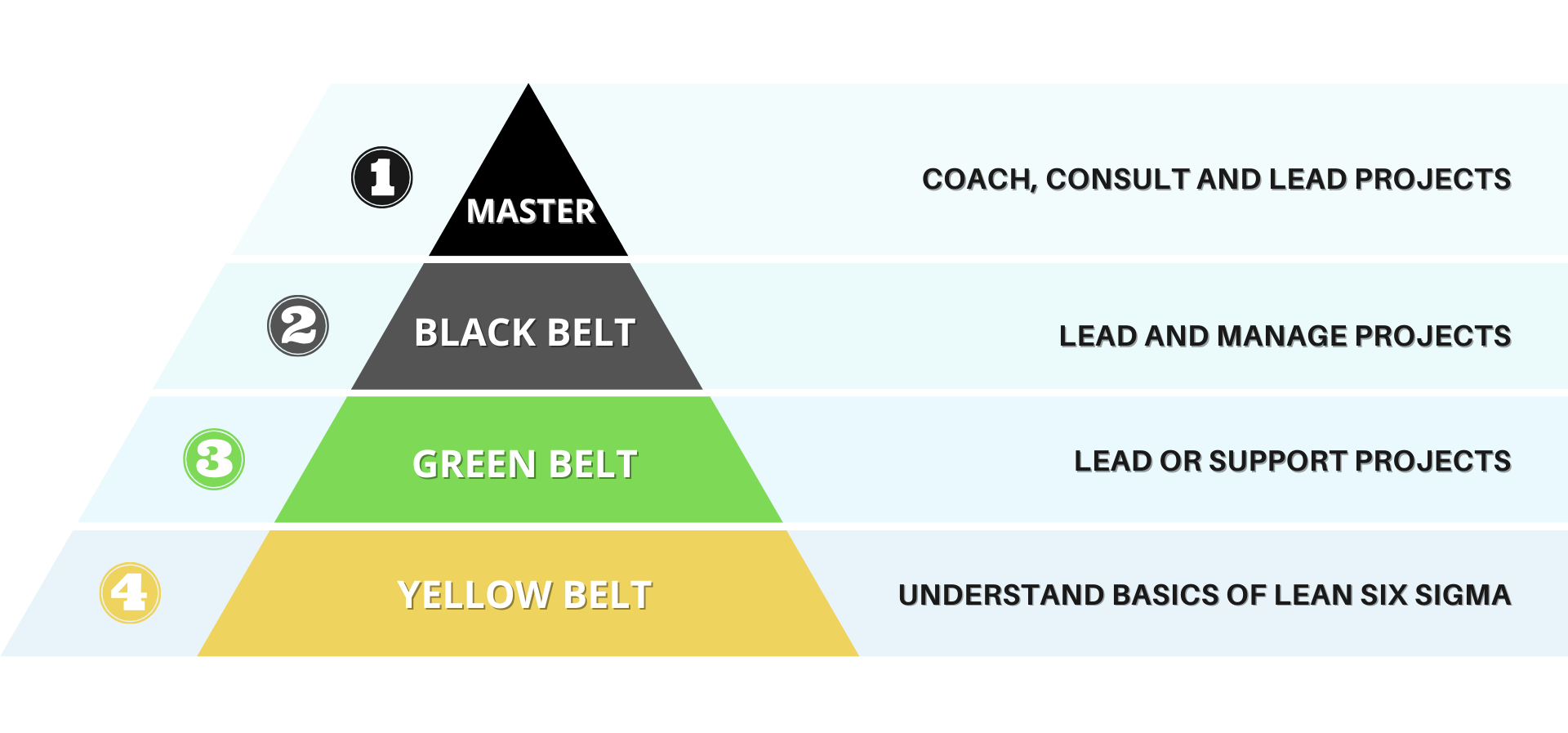Six Sigma Belts include the following: White Belt, Yellow Belt, Green Belt, Black Belt and Master Black Belt.
Six Sigma Belt Comparison Chart
PRICE
COURSE LEVEL
COURSE FOCUS
AVG. COMPLETION TIME
CONTINUING ED
(PDUs/PDCs)
SELF-PACED ONLINE TRAINING
INDUSTRY APPROVED CERTIFICATION EXAM
SUMMARY
Yellow Belt

$125
Beginner
Learn the basic tools of Lean Six Sigma
1-2 Weeks (20 Hours)
21 PDUs | 21 PDCs
Become familiar with the methodology and basic tools of process improvement.
green belt

$257
Beginner - Intermediate
Utilize Lean SIx Sigma tools within project teams
3-5 Weeks (60 Hours)
60 PDUs | 45 PDCs
In-depth comprehensive training for applying Lean Six Sigma tools and concepts.
black belt

$399
Advanced
Management focused for leading Six Sigma projects & teams
4-7 Weeks (90 Hours)
91 PDUs | 45 PDCs
Manage teams and lead projects to successful completion utilizing advanced Six Sigma tools.
master black belt

$699
Expert
Become a Lean Six Sigma mentor & coach
4-7 Weeks (90 Hours)
96 PDUs | 45 PDCs
Master the discipline of Lean Six Sigma at the highest level and educate others.
Professor Barry Shore PhD Explains Six Sigma Certification Levels
Lean Six Sigma Yellow Belt Certification
Lean Six Sigma Green Belt Certification
Lean Six Sigma Black Belt Certification
Additional Details
Each Six Sigma Belt prepares you for the next.
With that said, you can start from anywhere (Yellow, Green or Black), however the Master Black Belt is different. You must have a Black Belt Certification from a recognized organization before you can enroll into a Master Black Belt Program.
To get a better idea of which program is right for you, let’s take a closer look at each Six Sigma belt and their respected roles.
Six Sigma Belt Roles & Responsibilities
- Yellow Belt: Serves as a basic introduction to Lean Six Sigma for those new to the domain.
- Green Belt: Intermediate program that prepares you to work on process improvement projects within a company.
- Black Belt: Advanced program that prepares you to manage and lead project teams.
- Master Black Belt: Prestigious program that prepares you to educate others and become a master in the domain.
Where you start depends on three factors
- Educational Background
- Recency
- Experience
1. EDUCATIONAL BACKGROUND
Humanities majors including those who studied English, Art, Music, Journalism, Film or Foreign Languages should consider starting with the Yellow Belt since it primarily focuses on the conceptual issues of Lean Six Sigma. It focuses on where, when, and why, not how. The statistical foundation that helps to operationalize these concepts is left to the Green Belt and beyond. Those who have taken this Yellow Belt course have found it to be an excellent way to ease into the topic.
Those Liberal Arts Graduates with a background in Social Sciences, Economics and Natural Sciences should consider the Green Belt. Most have been exposed to math and statistics. This will increase the comfort level with the basic statistical concepts covered in the Green Belt.
If you have studied Math or Statistics you should be sufficiently prepared to proceed directly to the Green Belt.
Engineers, because of their strong quantitative backgrounds, should have no trouble with the Green Belt and may consider the Black Belt, especially those who are strong in statistics.
If you have a Business education, you should move directly into the Green. However, Marketing and Management majors could start with the Yellow. This depends upon your comfort level in statistics.
2. RECENCY
If you have been out of school less than five years, the skills you learned are very much still with you. In other words, you should still be comfortable with abstract or quantitative concepts. So, if you are out of school less than five years, this is not an issue and where you start depends more upon your educational background and to less of an extent upon the length of time you have been away from formal training.
But over five years, and this varies with any individual, you might consider dropping back a category; those who might have the background to take the Green or Black Belt program might fist consider taking the Yellow or Green Belt.
3. PROFESSIONAL EXPERIENCE
If you have experience in Lean or Quality management, if you are comfortable with mid-level statistics or quantitative reasoning and if you have not been away for long from formal learning experiences, then we recommend considering the Black Belt directly.
But, those who are changing careers, have been out of school for quite a while and are not
comfortable with statistics, should start with the yellow and maybe the Green Belt. The Black Belt would be too much of a reach at this time and is likely to frustrate you. Better to start at a level that is comfortable and work up then to become frustrated and quit.
Six Sigma Belts [Final Points]
Whichever Six Sigma Belt you choose – Yellow, Green or Black – we have designed our certification programs such that they lead you step-by- step through each stage of the learning process. And each step up the Lean Six Sigma Ladder includes a full review of the material that has come before. This is why you can comfortably begin at any level that is appropriate to your education, time away from formal training and experience.
So, begin with a level that is comfortable for you. In this way you can avoid the frustration of pushing too far too fast.
Looking to Become Lean Six Sigma Certified?
Check out our Lean Six Sigma Belt programs below:
